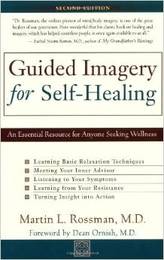
Rossman and I use very different terms to discuss the same phenomenon; his are more neutral and mine are more explicitly based in spirituality. What Rossman is essentially describing in this book about “imagery” is using one’s intuition to tune in to one’s body to listen to what it has to say. This is the premise of most of the healing work I do: Helping others learn to listen to what is going on in their bodies so that they can find the connections that Western medicine is missing. For Rossman’s perspective, individuals turn to their “internal advisor” or what I refer to as a spirit guide. He uses the term “imagery” for what I would describe as meditation.
Because he is grounded in science, Rossman integrates medical studies throughout the book. He talks about how visualization stimulates the brain in ways we don’t understand in order to help the body heal. As a method of comparison, he discusses how thinking about certain foods may make us literally salivate. This same phenomenon is at work, in his opinion, when we use imagery to help heal what ails us both physically and emotionally. We are able to gain insight into the issues behind our pain and then heal them by using imagery. In the case of someone fighting cancer, this might involve visualizing T-cells attacking a tumor. Rossman describes this (in what he admits are oversimplified terms) as using our right brain to heal instead of our left.
Citing studies, Rossman states that 50-75% of illness may have emotional roots. I’d say that the number is actually much higher and nears 100%. Regardless of how many people are impacted, Rossman cites the widespread emotional repression in our culture as a big part of that problem. He sees imagery as a way to get in touch with those things we've learned to repress as we avoid difficult emotional issues. The imagery he teaches people to use works to heal the people, not their illnesses. This is an amazing view not often found in Western medicine, though as Rossman notes repeatedly throughout the text, it’s important to seek medical treatment in addition to doing imagery work. The book contains chapters that deal with self-confidence, stress relief, healing and inner advisors; Rossman also adeptly deals with potential problems that may come up along the way. Some of the guided imagery sessions he creates in the text are also available on CD for use during meditation sessions.
For me, there were only a few issues with the book. What Rossman is describing is metaphysical work, yet he’s adapted it in a way to make it scientifically more acceptable to the mainstream. In doing so, he neglects the idea of spiritual protection. What he describes as critical inner advisors can sometimes be negative entities or deceased individuals who do not wish us well. The approach Rossman suggests of standing one’s ground is very effective for dealing with most deceased individuals, but for entities, one often needs more help than that to banish them. However, to acknowledge these issues would make Rossman’s book inaccessible to those who are turned off by ideas of the metaphysical realm and/or are atheists.
I found it very hard to stomach the idea of spirit guides as “inner advisors,” though the way Rossman presents the ideas is one done with respect to those of all belief systems. By taking this route, he limits what individuals can do with those "advisors" they make contact with. I can clearly see the advantages to this, but when I recommend this book to most of my clients, I will be making sure they know how much further they can develop these ideas with an understanding that spirit guides are not creatures of our imagination. They are real, just as you and I are real. Spirit guides just live on a different plane of existence than we do. It says a lot that it’s more acceptable to a science-minded population for us to create an imaginary friend to help us heal rather than accepting that higher powers may be interacting in our lives.
Rossman is also very conservative in encouraging people to change their lives radically. I don’t have that fear. Sometimes people need to turn their lives upside down in order to find healing. Rossman also assures readers that most people don’t have to deal with the horribly deep and dark issues they've repressed; I’d disagree with that as well. I think that for true healing to happen, those issues will eventually have to be confronted. However, if one follows one’s inner guidance and works in slow steps to heal as the body and soul need to, once it comes time for confronting the major issues, most people will have done the pre-work necessary to make the confrontation far less painful than it would originally have been.
In the updated version of this book that I read, chapter 15 is a dry history of body-mind healing, and chapter 16 is a summary of the science behind body-mind healing. For most readers, these chapters will not add to their experience and I’d recommend skipping them. I suspect they are at the end of the book for this very reason. Many readers would quit reading if they were introductory chapters.
Overall, Guided Imagery for Self-Healing is one of the better books I've read on meditation and healing from a mind-body(-spirit) perspective. I've already recommended it to one person, and I plan to recommend it to several others after this review publishes and I can send them the link. I’ll also be using most of the guided meditations with my spiritual singles group as they are wonderful resources for everyone who wants to heal on multiple levels.
© 2015 Elizabeth Galen, Ph.D., Green Heart Guidance, LLC
 RSS Feed
RSS Feed